The majority of members still opted for time trialling as their chosen discipline. It fitted in well with traditional club life and touring and did not necessarily call for any extra equipment or preparation other than for their normal riding. All they had to do before a TT was remove their saddlebags and mudguards, reverse the rear wheel to get a higher (fixed) gear and they were away.
In the late 1940’s Charlie Roberts and Tommy Ginn were riding well, as were the Armstrong brothers, Sid and Fred, either on two wheels or three. Among Roberts’ successes in 1947 he took the Southern Counties C. U. 50 miles trophy. Ginn placed second in the Balham Rough Stuff of 1948 (the title varied over the years between Roughriders, Rough Riders, Rough Stuff and Roughstuff ) and with John Smith 4th and Bill Boynton 5th the team was theirs. Held partly off-road on the Surrey / Kent border spectators were always out in force particularly at the water-splash at Limpsfield.
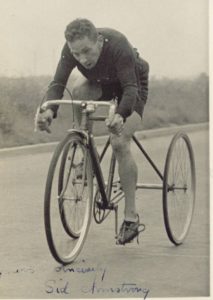
The same year Sid Armstrong (pictured) knocked 7 minutes off the Southern Road Records Association (SRRA) tricycle 50 record and 50 seconds off the RTTC 30 miles Competition Record while Stan Harvey added 38 miles to the SRRA 24 hours bicycle record and Bill Boynton set a time of 5.21.52 for the SRRA Winchester to Canterbury record. The following year, 1949, Harvey, partnered by Eddie Mundy, broke three SRRA records: the 12 hours, adding 18 miles, Purley to Eastbourne and Back by 3 minutes and they reduced the year-old Winchester to Canterbury record by 31 minutes. Callanan and Brown of the Norwood Paragon broke in the meantime Mills and Paul’s 100 miles SRRA record of 1938. Eddie Mundy placed third in the SCCU 50 and John Watts finished runner-up in the SCCU 100.
Snow and ice proved a tricky problem for the competitors in the Kingsdale Hardriders event in 1947. Tommy Ginn (pictured) finished in fourth position with Ray Cook seventh.
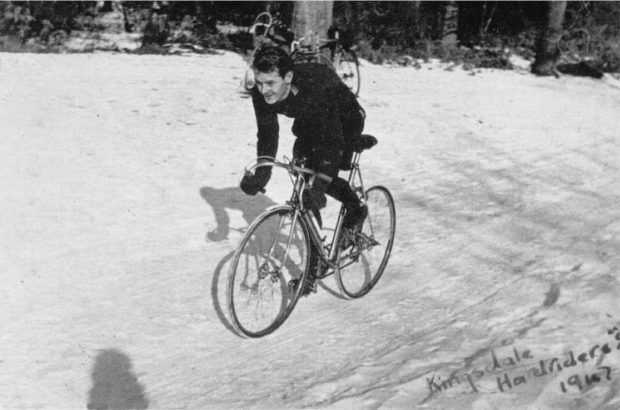
Stan Harvey (pictured) had joined the club in June 1929 and in 1947 decided to take on the 10 years old SRRA 24 hours record, his ride of 434 miles adding nearly 38 miles to the previous record. He followed this up with a ride in the North Road 24 that saw him finish in third place with 431 miles to his credit. Pictured: Harvey riding a Davey frame built by Ray Cooke
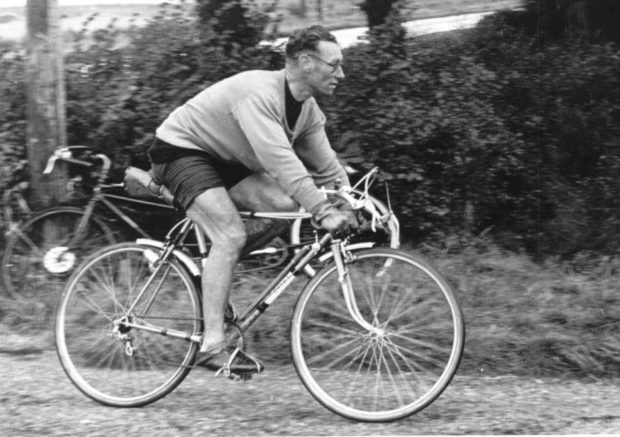
The RTTC decided to institute a National 24 Hours Championship, the first event to be the North Road 24 of 1948. Harvey rode and, despite going off course for about five miles, improved his mileage to 442 miles to take the silver medal position, 12 miles behind the eventual winner, Gordon Basham, Wessex R.C., 454.37.
The next year the event moved up to the Cheshire area with a long leg out along the Welsh coast. Harvey’s early season training schedule had been to cover 400 miles per week and he and Charlie Davey reconnoitred the course round the roads of Shropshire, Cheshire and North Wales in the week immediately prior to the event itself. Starting last but one in a field of 58, Stan had ridden steadily into the leading position by about 160 miles and despite two punctures maintained his dominance to run out the National Champion of 1949 with 439.97 miles. This was his first ever win in 20 years of racing. It was an elated group of helpers who returned to Addiscombe and booked their tickets for the All-Rounder Prize Presentation and Concert that year.
Time trialling was still the most popular competitive discipline of the club. Bill Boynton opened the 1950 season with a win in the Balham Rough Stuff. The watersplash at Limpsfield nearly always claimed a few victims as Fred Spittles and Alf Cook (pictured) found out that year!
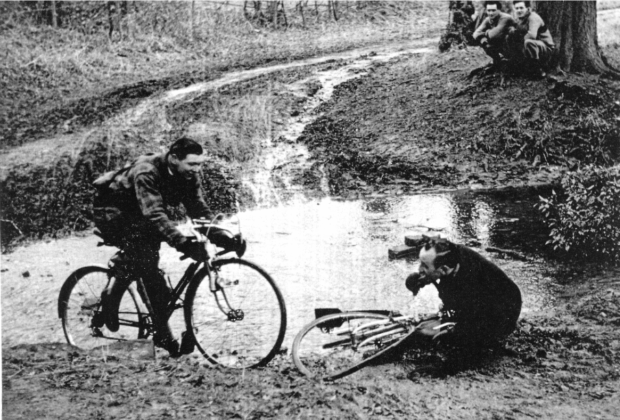
With the recent big surge in membership Alan Grist, Alan Drury, John Miles, Bill Titley, Bernard Hastings, Gordon Elliot, Ken Bush and others too numerous to mention supported the club’s rising young star, John Smith. Longer distances were favoured by Jim Trenowden, Sid Armstrong, Keith Wawman, Eddie Mundy, Stan Harvey, Gus Andrews and John Watts, the latter three only just missing out on the Luton 12 hours team award. Most track riders also competed in the shorter distance club events. Open 10’s for the over 18’s were still years away.
Stan Harvey’s rides had inspired the long-distance riders to think beyond 12-hour events and with Charlie Davey’s vast experience and guiding hand four entered the National 24 Hours Championship of 1950 run by the Western Time Trials Association. Norwood Paragon rider Stan Butler was also competing, and the event proved a ding-dong battle between Eddie Mundy and Butler. Mundy being a slightly earlier starter completed his 24 hours riding first with a mileage of 455.91, a new RTTC Competition Record. This was not to stand for long and Butler finished with 458.18 miles to take the Championship title and increase Competition Record yet again. Eddie Mundy had to settle for the silver medal although he was credited with having broken the record first. Meantime Stan Harvey finished 3rd with 445.73 miles, another improvement for him, and diminutive Sid Armstrong, in 4th place, completed the winning team with 440.30 miles, bettering the previous Team Competition Record by 57 miles. Addiscombe’s fourth man John Watts finished in 11th place with a very creditable 421 miles. Later in the season Gus Andrews won the SCCU 12 hours and with Watts and Mundy took the team. Sid Armstrong took the SRRA tricycle 100 miles record, reducing the time by 9.5 minutes to 5.14.25 and Harvey and Mundy added the London to Worthing and back tandem record to their SRRA honours.
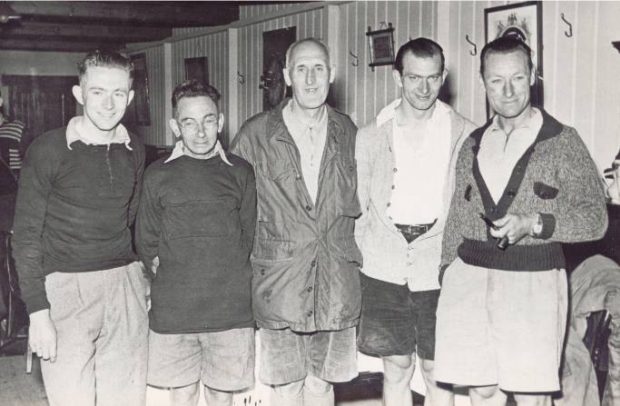
Charlie Davey, always a generous benefactor to the club, put up a fine silver bowl as a permanent trophy for the Men’s Open 50 miles time trial. Despite a fine effort John Smith was beaten by a mere 20 seconds by Vin Callanan, Norwood Paragon. Eddie Mundy finished fifth fastest and Cyril Hinton eighth, but the Paragon took the team award with first, fourth and seventh places.
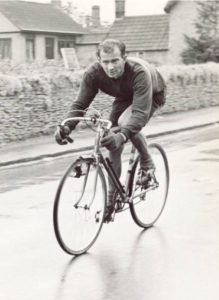
The next few years were to be another memorable period in the club’s annals. John B. Smith had joined the Addiscombe in 1946 as a noisy youngster with a huge appetite! In 1951 it was his turn to win the season’s opening event the Balham Rough Stuff. Bill Boynton finished 3rd and with Jim Trenowden 7th they took the team prize. By the end of the time trial season (late February to early October) “JB”, as Smith became popularly known, was turning out consistently good 50’s, had been placed 16 times and had broken club records on six occasions. He finished the season by winning the Hounslow 25 with 59.40, one of the select few riders now “under the hour”.
An early season tragedy had overtaken Tim Carter in 1950 when he was involved in a training accident and lost an arm. He did return to the club life for a while and 1951 saw him riding a few time trials again.
1951 was the year the 24 Hours Championship was being run close to home. Organised by the Catford C.C. on southern roads they always opted for the July weekend nearest the full moon to give competitors the maximum light by night. Weather conditions turned out near perfect. Depth of talent in the club was to show when Gus Andrews, in only his third year of racing and riding his first “24”, ran out the winner with 461.31 miles, another National Competition Record.
Five members had entered the event and with Stan Harvey finishing third, 450.09 miles, and John Watts 5th, 440.21 miles, another 10 miles was added to the Team Competition Record. Our two other entrants both finished, Sid Armstrong 9th with 429 and Jim Trenowden 10th 428. Pictured, Gus Andrews taking a drink from Eddie Mundy on the finishing circuit at Keepers Corner, Copthorne, with club members looking on.
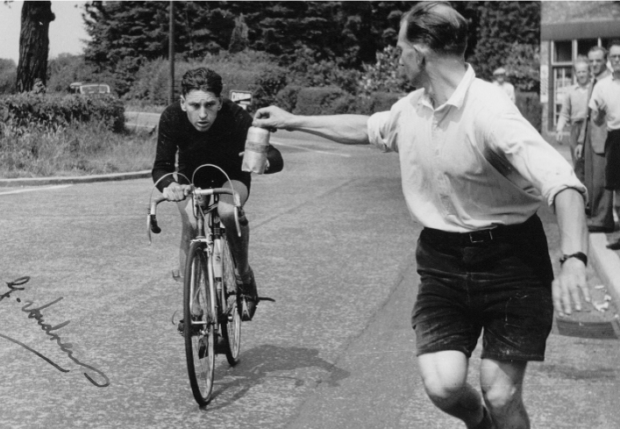
The Open events tally for the year for both sexes makes interesting reading. It was eight 1st placings, eleven 2nd fastest, twenty-three 3rd fastest. three 1st handicaps, three 2nd handicaps, four 3rd handicaps, seventeen team wins and six times team runners-up. The total of participating riders in Open and the fourteen club events was seventy-three men and ten girls.
A steady downpour of rain made for treacherous conditions, but John Smith again won the Balham Rough-Stuff of 1952 with Alan Drury fifth. Smith followed this with wins at every distance from 25 miles to 12 hours. Not only did he win the South Western R.C. 12 hours at his first attempt at the distance but followed this success by winning the Southern Counties C.U. 12, a ride good enough to earn him the title of Southern Counties Best All-Rounder of 1952.
Peter Short, Ron Rand, Ron Drake, Cyril Hinton, Micky Jasper, Bill Curr, Trevor Williams, Les Ward, Mike Page, Richard (Dick) Wiseman, Bill Currier, Claud Perry. Brian Nicholls, Ken Willoughby, Mike Page, Rodney Metcalfe, the list of time triallists appears unlimited in the early 1950’s. These are just a few who appeared regularly, in addition to those listed earlier and who were still riding strongly. Diminutive Sid Armstrong (affectionately known as “The Mighty Atom” or “Mickey Mouse”) and brother Fred were performing well in events run by the Veterans Time Trial Association and the Tricycle Association. They both did sterling work for the club for a period of over 30 years.
In the Wessex 24 Stan Harvey managed to go off-course twice and was not very well received when he had to disturb a courting couple in a phone box for directions on how to get back on the correct road! He still managed to win the event with a ride of 440 miles. Eddie Mundy and wife Pat were part of his back-up team on a tandem and Mundy recalls how they themselves covered nearly 300 miles looking after Harvey.
Stan Harvey and Eddie Mundy added a further SRRA record to their list in 1952 when they broke the Dover to London and Back record in the time of 6.25.15. This bettered the previous record by nearly 12.5 minutes. This was their fifth, and last SRRA record. Pictured, Eddie Mundy has taking up a drink that will then be shared with Stan Harvey.
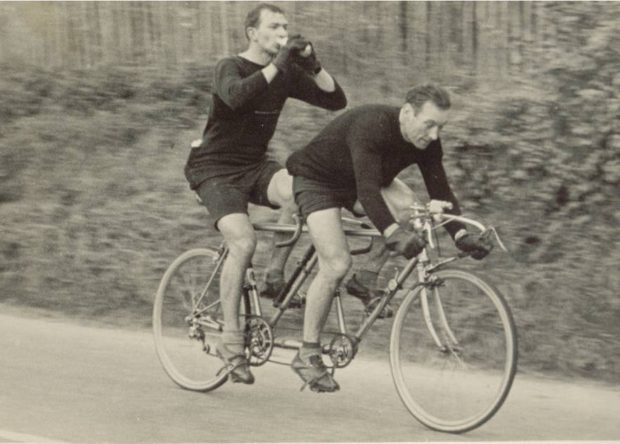
The North Road C.C. promoted the 1952 24 Hours Championship and Addiscombe had six entrants. This was definitely to be Eddie Mundy’s turn, riding a consistent race to finish with 467.52 miles. Yet another National Competition Record. Past Champions Gus Andrews finished 3rd with 449 miles and Stan Harvey 5th, 447 miles so yet another Team win and 10 more miles on the record. (The journalist Jock Wadley in reporting the event jocularly commented that to Davey, their manager, the most important part of the Addiscombe C. C. was the word “Add”.)
A northeast wind had brought icy cold conditions during the evening of the race and by early morning had taken its toll. As the event wound its way up the A1 and round the Fens many riders had been forced to retire including Sid Armstrong and John Watts. Harry Crumbley, another member of long standing and one who did much for the organisation of the Club, ran out with 406 miles, a good ride in the bleak conditions.
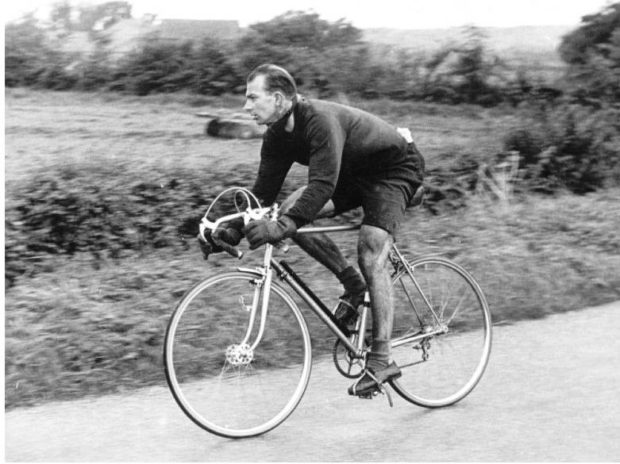
G. H. Stancer* wrote in the Cycling magazine that he had witnessed nearly every winner of the North Road event since it had become an unpaced event (1900) “…and that he had seldom seen a man finish so full of running, so untroubled and untired, as this great Addiscombe rider. And what a club! In four years they have produced three 24 hours champions, all different”.
*Editor of Cycling 1910-1919 and a lifelong contributor to the magazine
Sid Armstrong, time trial secretary in the early 1950’s, took pride in recording not only everyone’s ride but also in publishing them in The Gazette. The minutes around this period record three riders having been reported for entering an Open time trial without first notifying the racing secretary, such was the club’s procedure. It was decided by the committee that on this occasion no action would be taken against them! The end of year time trial tally of awards taken by both sexes in 1952 was fifteen fastest times, eleven 2nd fastest, eleven 3rd fastest, two 1st handicaps, six 2nd handicaps and one 3rd handicap. Twenty-eight members had shared in the team awards and fifteen members had taken individual awards.
At the 24th Annual Dinner in January 1953 where Eddie Mundy was acclaimed for his magnificent Championship win in the North Road C.C.’s event it was fitting that the chief guest should be from the promoting club. A. C. Baynes, North Roads C.C. but better known to the general public and radio listeners as the comedian “Stainless Stephen”, provided members with a most entertaining speech. The Press too were well represented by another North Roader, the Editor of “Cycling” H. H. England, and Jock Wadley of “The Bicycle”.
John Smith opened the 1953 season with a win in the Calleva Medium-Gear 25 and then went to ground for much of the season having dental problems sorted but he managed to come back at the end of the year to break the club’s 25 miles record with 59.14. For the first time in 25 years an Addiscombe rider was placed in the Kentish Wheelers Novices 25, J. A. Boon finishing just 30 seconds slower than Zafos of the Kingston Phoenix. Mick Blake, Mick Jasper and Claud Perry scored a team win in the Hemel Hempstead 25 and Blake took the club’s 30 miles record with a ride of 1.11.49. The Armstrong brothers continued scoring in Veterans T.T.A. and Tricycle Association events meanwhile a team riding in the Men’s National Championship 12 (always a hotly contested event because of the National Best All-Rounder) saw Gus Andrews finish 8th, 247 miles, with Eddie Mundy close behind 244, Keith Wawman 233, and Jim Trenowden 230.
All good things come to an end and the club’s run as the Gold Medal 24 hours specialists finally ran out with the Mersey Roads Championship promotion in 1953. Helpers had gone to Chester via bicycle, train and motorised transport. Dick Penton and passengers were heavily delayed in traffic and picked up a puncture en route, Jack Hall and crew missed the rendezvous point with Charlie Davey, and to make matters worse it was raining steadily. The rain cleared just in time for our first man, John Watts, to start. Eddie Mundy rode well but lost 10 minutes off course during the evening and finished with 448 miles, but still runner-up to the winner’s 459 miles. Stan Harvey, now riding his tenth “24” finished in fourth position with 435 miles. Sadly, of the other two entrants, Gus Andrews packed around 287 miles and John Watts “was lifted off his bike before he fell off” at 315 miles. The same weekend the Wessex Roads were running their 24 in the South. Jim Trenowden ran out third with 418 miles though even that would not have been enough to get the Addiscombe the team title had he been riding in the Championship. Les Ward finished sixth with 412 miles.
The 1954 season was to prove another great year for the Club. John Smith set the ball rolling with his third win of the Balham Rough Stuff and Brian Nicholls placed 2nd in the Kentish Wheelers Novices 25 with 1.3.44. On 9th May, two team victories were achieved. Smith 2nd fastest with Bill Titley and Rodney Mackinlay taking the SCCU 50 and Brian Nicholls 2nd fastest, with Ray Root and Dick Wiseman scoring in the Uxbridge Wheelers 25. John Smith then bettered Ernie Mills’ 1937 100 miles record when he won the SCCU 100 and reduced the time still further to 4.19.40 when winning the De Laune 100 a week later.
This was a year that once more saw many different riders competing. Peter White and Mick Blake were finishing well up in tandem events, 2nd fastest in the East Sussex 30, 4th in the Viking 50 and 6th in the University 30. Dick Wiseman was riding well in distances up to 50 miles and took 2nd place in the Aldershot 50.
As if to prove they were not finished yet, with the 1954 Championship 24 being run by the Wessex Roads Club, Andrews, Mundy and Harvey regained the National Team title finishing in 4th, 5th and 7th positions respectively. Conditions started well in the morning but deteriorated during the last two hours with heavy rain making all riders pleased when their 24 hours elapsed.
Before the season was out John Smith had won another three 50’s and finished fifth in the National 12 Hours Championship. Ray Booty took the title with 257.29 miles, Smith broke club record with 252.01 and backed by Keith Wawman 244 miles and Gus Andrews 239 miles they were placed second team. Smith also reclaimed the SCCU BAR title that he had first taken in 1952 and would take again and again in addition to various individual SCCU trophies.
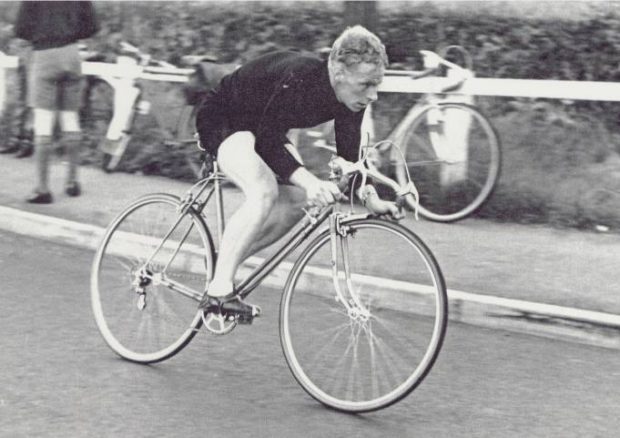
A quieter but none the less competitive year for the men followed in 1955. John Smith was beaten into fourth place in the Balham Rough Stuff and Ken Bush (below) finished 15th.
Robin Kingsland, riding in his first time trial, finished 2nd fastest in the Delta Longmarkers 25. Alan Grist was time trial secretary and reported he had at last managed to get some satisfactory club racing vests. Made in a ‘silky-cotton’ material with short sleeves and front and rear pockets they would be 31/- each. (£1.60 – but wages were also very different from today!).
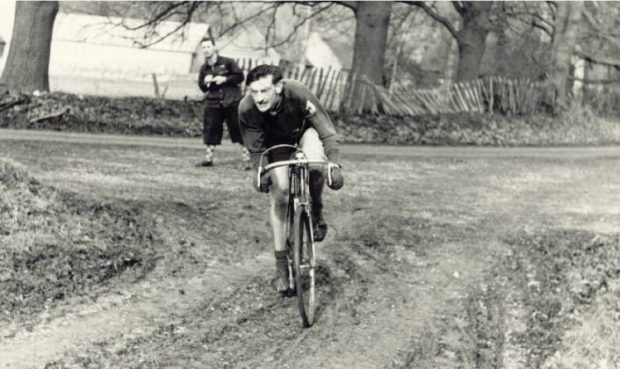
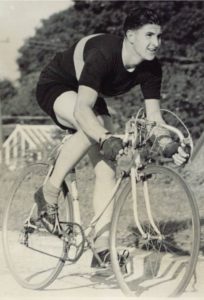
The Armstrongs were finishing well up in VTTA events. Our only rider to finish in the Championship 24, a Catford promotion back on southern roads, was Rod Mackinlay (pictured) with a steady ride of 433 miles for 13th position. John Smith was placed in several events but in the National Championship 12 Stan Harvey went nearly two miles further than Smith just to show that even at his age he was still in the reckoning. Eddie Mundy completed our trio. Smith then placed 2nd in the Southern Counties 100 and won their 12 and with it his third Counties BAR. The Surrey Centre NCU hillclimb was won by Bill Edwards, albeit that he had been called up and was riding in the colours of R.EM.E. (Royal Electrical & Mechanical Engineers).
Tim Smith, Clarencourt C. C., won the Addiscombe Men’s Open 50 of 1955 in 2.08.10 with John Smith once again second fastest, 2.08.45. Sid Armstrong recorded that fourteen of the eighty-nine entrants were Addiscombe members and that the reason for the slow times overall was slippery roads “causing several riders to fall including Ken Tuffnell and Ken Bush, the latter’s wheel folding up as he fell”. As with earlier years the number of men riding time trials in the club’s name means it is not possible to mention everyone but they finished the season with seven team wins, plus numerous placings, handicap and group awards.
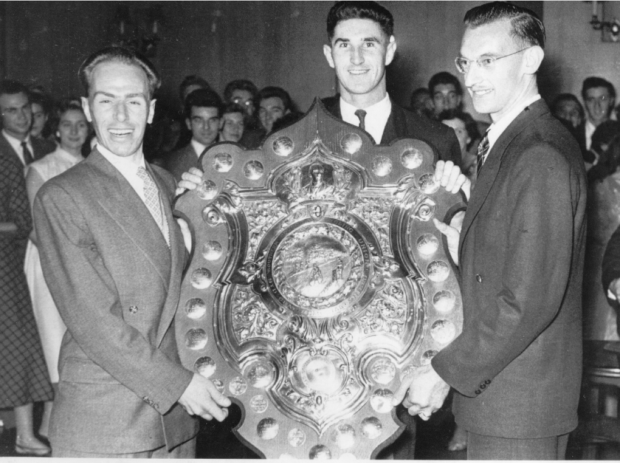
1956 and John Smith once again opened the season with a convincing Balham Rough-Stuff win, even beating Alan Jackson, the National cyclocross champion. Eric Hall and Ron Pitt were making their debut in the event and experienced the thrills and spills of a traditional Balham, an event that was instigated in 1927.
John Smith won the SCCU 100 with 4.16.37, course and club records, and scooped 3rd handicap at the same time. With Ray Root 4.36.40 and Eddie Mundy 4.40.57 another team win was in the bag. Smith followed this with a 6th place in the National 100 and a new club record, 4.15.57. His win in the South Western R.C. 12 gave Smith an opportunity to raise the club record to 253 miles. In the SCCU 12 although he finished in second place it resulted in his fourth win of the Southern Counties BAR, plus the Counties 12 hours team with John Watts and Eric Hall and the Counties BAR team with Trevor Williams and Ken Bush.
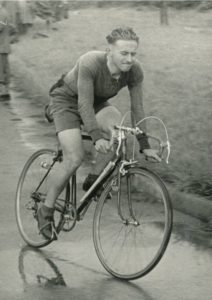
The trio of Stan Harvey, Eddie Mundy and Gus Andrews rode in the National Championship 24 for the last time with the event back on the North Road course. Although Andrews was forced to retire Harvey and Mundy finished with 442 and 437 miles respectively.
By 1957 local time trial courses were in a state of flux due to the expansion of Gatwick Airport. In post-war years the popular 25 miles course had started immediately south of Redhill, headed southwards on the A23 through Salfords and Horley to the Tushmore roundabout north of Crawley (since the 1990’s now peppered with traffic lights). Riders then turned right, still on the A23, to the second roundabout, right towards Horsham on A264, to turn in the middle of what was then a single carriageway road, opposite the Cherry Tree PH at Faygate. The route retraced to Salfords to fork left and finish along by Earlswood lakes. This was a good course within comfortable riding distance from South London. With the development of the airport the route of the A23 beyond Horley had to be moved eastwards, adjacent to the railway, to enable a sufficiently long runway to be constructed. New time trial courses were designed based firstly on Charlwood, then Pease Pottage, and then Broadbridge Heath, as road alterations necessitated courses moving further and further away from London and the larger conurbations.
The Addiscombe’s long distance enthusiasts were no longer competing in 24’s and the women’s team was very depleted with the raising of families taking priority. J. B. Smith started his season early with 2nd place in the Balham Rough Stuff. Among the veterans, George Richens and the Armstrong brothers, Sid and Fred, were riding well and achieved an early team win in the Veterans TTA 25. John Gifford won the Thornton R C’s Junior 25 in 1.04.21, a sign of greater things that were to come from him.
After three second placings in previous Addiscombe Open 50’s, J. B. Smith at last scored a victory in 1957. Always a strong rider, Smith took advantage of a very rough, wet and windy May morning when a third of the field failed to present themselves to the timekeeper. Robin Kingsland finished second fastest and with Peter White they scored a team win. Three other Addiscombe members, Ken Tuffnell, Bill Currier and D. Johnson finished second fastest team. In the handicap section Smith was again fastest and Kingsland second.
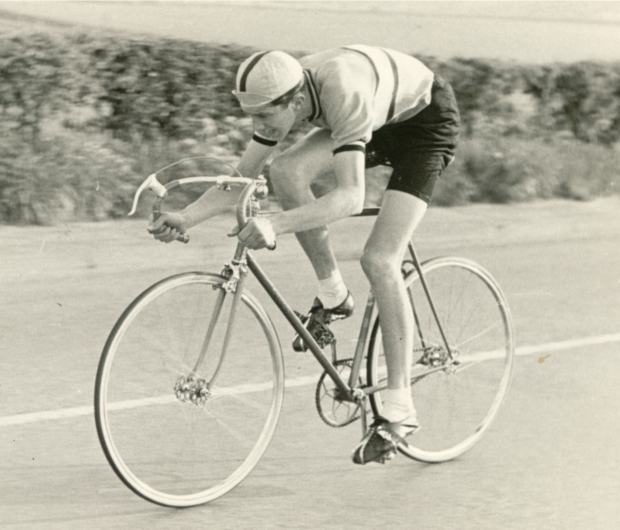
By the season’s end John Smith had scored six wins in time trials including team victories in the Kentish Wheelers 100 with John Watts and Bill Currier, the Southern Counties C.U. 100 with Sid Armstrong and Currier, the SCCU 12 hours with Watts and Currier, plus the SCCU Best-All-Rounder individual title and team with Currier and Armstrong. Smith also set a new club record of 254.49 miles in the 12 and took ten second placings in Open events. Dick Wiseman, new member John Wynter and Ron Rand set a new club 30 record of 3.49.39 in the Leo Road Club event.
- An Introduction to our History
- The 1883 Addiscombe Cycling Club
- The 1906 Addiscombe Cycling Club
- An Historical Background to the Road Record Associations
- A Brief Historical Background to Cycling Time Trials
- The Club’s Revival, 1929 to 1939
- The Club in Wartime, 1940 to 1946
- The Post-War Years, 1947 to 1957
- Post-War Track and Roller Racing
- The Men in Post-War Time Trials
- The Women in Post-War Time Trials
- Post-War Closed Circuit and Road Racing
- An Influx of New Riders and the Passing of a Statesman, 1958 to 1964
- The Club Heads Towards its Golden Jubilee, 1965 to 1978
- Membership Declines, 1979 to 1987
- The Arrival of the Young Mountain Bikers, 1988 to 1994
- Another Period of Declining Membership, 1995 to 1999
- New Century and a New Look for the Addiscombe, 2000 to 2006





